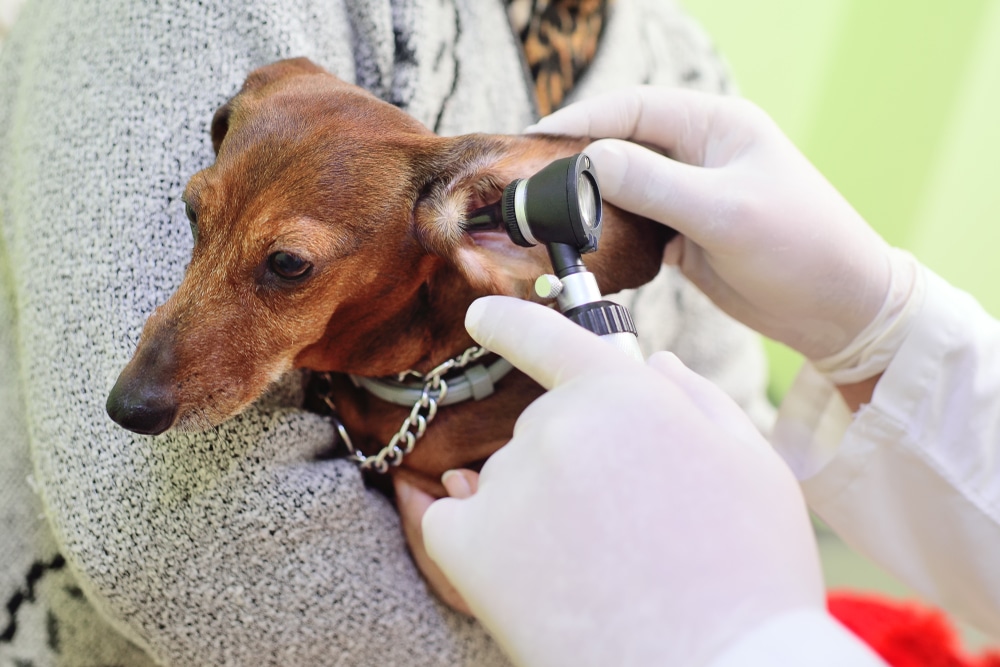If your dog is constantly shaking its head, or the insides of its ears seem smelly and moist, you may be dealing with an ear infection. These can be frustrating as the course of treatment is often prolonged and repetitive. Pet parents are left wondering how to cure a dog’s ear infection once and for all.
When it comes to how to cure a dog’s ear infection, in up to 40% of dogs with ear infections, the condition is often a secondary consequence of allergies or inflammatory skin conditions such as atopic dermatitis. A thorough workup by your veterinarian will allow them to identify and address the root of the problem. Remember, ear infections are painful at any stage, and providing rapid relief to your pup is always a vet’s first priority!
Table of Contents
What Is An Ear Infection?
Before thinking about how to cure a dog’s ear infection, we need to start with what an ear infection is. Ear infections occur due to inflammation in the lining of your dog’s ear canal. There are three types. Otitis externa is the most common form and affects the vertical and horizontal canal, external to the ear drum. Otitis media and interna usually occur secondary to otitis externa as the inflammation progresses further into the ear.
Predisposing Factors That Lead To Ear Infections
Predisposing factors related to conformation, environment, and excessive grooming can increase the likelihood of your dog developing an ear infection.
Certain anatomical factors can contribute to maintaining a moist environment within the ear that precipitates infection. Some such as brachycephalic or short-nosed breeds such as the Pug or French Bulldog tend to have narrower ear canals.
Poodles, Shih Tzus, Schnauzers, Maltese, Bichon Frises, Lhasa Apsos, and other long-haired breeds tend to have hairy ear canals.
Hounds, Retrievers, Spaniels, and Setters have long pendulous ears that droop downward.
These anatomical factors can contribute to reduced airflow and maintenance of a moist ear environment that can increase the chances of ear infections.
Dogs that spend a lot of time in high-humidity environments and enjoy swimming or playing in water regularly may also end up with those high-risk moist ears. Grooming is necessary to keep your dog’s ears clean and dry. But overdoing it or using the wrong products can cause irritation. Recent recommendations dissuade plucking out the hair in healthy ears because it can cause microtrauma to the skin where infection can set in.
Some diseases such as hypothyroidism or hyperadrenocorticism put your dog at risk of ear infection.
Expected Clinical Signs
The first signs in dogs developing an ear infection are usually whining, head shaking, and persistent scratching or pawing at the ears. The ear may appear red or swollen, and if you’re brave enough to give it a whiff, a sour or musty smell is characteristic. Some dogs may become aggressive or shy away from touch because their ears become very painful.
Primary Causes
Ear infections are often a symptom of a separate underlying issue. Treatment requires a systematic step-by-step approach to identify and rule out the primary cause.
Some common issues related to the development of infections in healthy ears include the following:
- External parasites such as mites and ticks
- Certain types of fungi
- Excessive build-up of earwax
- Partial or complete ear canal obstruction due to foreign materials or tumors
- Auto-immune disease
- Hormonal abnormalities
- Allergies to food, environment, cleaning solutions, and medications
Secondary Causes
After the primary factors listed above have established inflammation, it provides the ideal environment for bacteria, yeast, and fungus to permeate and worsen the condition of an already abnormal ear.
Treatment with antibiotics, antiseptics, or fungal creams alone will only address these secondary agents and will not provide long-term relief for your dog. For lasting relief from ear infections, the vet must identify and tackle the initiating primary cause.
What To Expect At The Vet

Getting your vet involved with a dog’s ear infection is essential to the recovery of your dog’s ear. Here’s what a vet can do.
The Diagnosis
The first step to identifying the source of your dog’s ear problems is to obtain a thorough history. Before you visit the vet, think back and be prepared with answers to the questions they may ask.
Questions The Vet May Ask
Here are some possibilities:
- When did you notice the symptoms of your dog’s ear infection? If this isn’t the first time your dog has had this problem, try and recall the details of the other episode or episodes as well.
- If your dog has previously been treated for this issue, what medication was given and how did they respond to treatment?
- Does your dog have any prediagnosed allergies or medical conditions?
- What, if any, medication is your dog on?
- What do you feed your dog? Has there been any change in diet or the addition of any extra treats or snacks?
- How often do you clean your dog’s ears or send it to the groomer? Do you or your groomer regularly pluck its ear hairs while cleaning?
- Has your dog been bathing, swimming, or playing in water recently?
- Is your dog on regular parasite control?
Make sure you or the person bringing your dog to the vet is well informed of the dog’s lifestyle and habits. Accurate information from pet owners narrows down the diagnostic process and may significantly reduce the time and costs involved.
The Physical Exam
Next, your vet will perform a thorough physical exam that includes extensive handling of your dog’s face and ears. If your dog seems extra grumpy because it’s nervous or in pain, ask your vet about muzzling or medication to calm your dog and reduce discomfort before your visit.
Some vets may use an otoscope to look inside the ear canal. They may also collect samples from the ear that they will assess microscopically. A bacterial culture and antibiotic sensitivity test may help determine the best medication for your pet. Your vet may perform other diagnostic tests based on your pet’s needs.

Ear infections are often only a sign of many possible underlying conditions. To successfully treat them, your vet must perform a series of systematic tests to rule out or rule in a definitive diagnosis. The process may be short – as quick as one visit – or prolonged, depending on the case. In cases of allergies, for example, food hypersensitivity trials can take up to two months.
The Treatment Plan
Your veterinarian will perform a thorough cleaning using a medicated cleanser. If the ear is too swollen and painful during the first exam, it is common for clients to be sent home with medication to reduce pain and swelling to ensure patient comfort. You may be asked to revisit once the swelling subsides.
Once the issue has been identified, your vet will recommend a course of topical or oral medications to treat the infection and address the underlying cause. Newer, milder infections usually resolve in a couple of weeks. Please make sure to finish all the medication as prescribed by your vet even if your dog’s symptoms seem to have improved. Stopping halfway can cause the infection to come back stronger!
In dogs with chronic and recurrent infections, the canal may have become permanently swollen and narrow. In such situations, your vet may recommend surgery to remove the ear canal. This procedure provides long-term pain relief to dogs who have been suffering from ear disease for a long time. Owners of dogs who have had the procedure report a positive shift in personality after surgery, likely because their pup is no longer in pain. Most owners also do not report an identifiable hearing loss.
How To Prevent Ear Infections
When it comes to ear infections, prevention is better than a cure! If your dog belongs to any of the breeds with predisposing factors or has any predisposing characteristics, regularly checking the ears can help identify an infection in its early stage when it is easiest to treat. Also, regular checkups with your veterinarian allow for a more thorough examination of the ear and can help to identify primary factors such as tumors and systemic disorders early on.
Pet owners can and should clean their pets’ ears at home using a high-quality ear cleanser. To do so, fill your dog’s ear with the cleansing solution and gently massage the base of the ear until you hear a squishing sound. Use gauze to absorb the liquid and wipe the ear canal.
Avoid going deeper than one knuckle. Do not use q-tips or cotton swabs to dig deep into your dog’s ears as this can push debris deeper into the ear and cause trauma to the sensitive lining of the canal.
Using DIY products to clean your dog’s ears isn’t recommended because they often use water or alcohol as a base. This can leave the ear too moist or too dry and perpetuate inflammation. Plus, alcohol is very dangerous for your dog and shouldn’t be used anyway. Basically, when it comes to how to cure a dog’s ear infection, DIY methods and products do the opposite of a good job.
In Conclusion: A Dog’s Ear Infections Are Common And Very Curable!
Up to 20% of all dogs experience at least one episode of an ear infection in their lifetime. In some breeds, the prevalence is much higher. Early detection and persistent treatment is the key when it comes to how to cure a dog’s ear infection. Make sure you communicate with your veterinarian to fully understand and comply with the diagnostic and treatment plan to keep your pet happy and infection free.
So, is anything going on with your dog’s ears? We hope not, but if they are, let us know what’s going on in the comments below!
